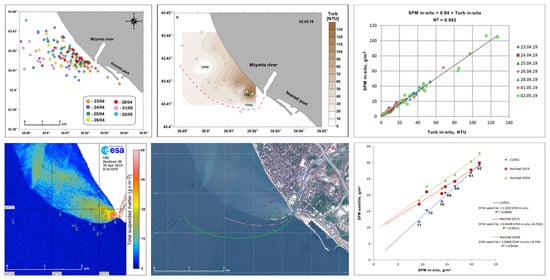Comparison of In Situ and Remote-Sensing Methods to Determine Turbidity and Concentration of Suspended Matter in the Estuary Zone of the Mzymta River, Black Sea
Abstract
:1. Introduction
2. Study Area, Data and Methods
2.1. Study Area
2.2. Data and Methods
2.2.1. Boat Measurements
2.2.2. Laboratory Study
2.2.3. Satellite Observations
3. Results
3.1. Meteorological Conditions
3.2. Results of In Situ Measurements
3.2.1. Variation of Temperature, Salinity and Turbidity in the Near-Surface Layer
3.2.2. Spatial Distribution of Temperature, Salinity and Turbidity in the Plume
3.2.3. Depth Distribution of Temperature, Salinity and Turbidity
3.2.4. Results of Portable Turbidimeter (PT) Measurements in the Near-Surface Layer
3.2.5. Correlation Analysis of Turbidity and Suspended Particulate Matter Concentration (SPM) from In Situ Measurements
3.2.6. Sampled SPM and Mineral Composition of Suspended Matter
3.3. Results of Satellite Observations
3.3.1. Satellite Data Processing and Products
3.3.2. Plume Boundary Detection
3.3.3. Correlation Analysis of SPM from Contact and Remote-Sensing Data Using Case 2 Regional Coast Color (C2RCC) Algorithm
3.3.4. Correlation Analysis of SPM and Turbidity from Contact and Remote-Sensing Data Using Different Algorithms
4. Discussion
- Data from two turbidity sensors–an optical turbidity sensor as part of the RBR-concerto CTD probe (TM) and a TN400 portable turbidimeter (PT). Both sensors provide data in NTU units and work roughly on the same principle. A significant difference is that turbidity measurements were taken at different depths, since it is impossible to obtain data in the first centimeters from the surface with the CTD probe.
- Data on SPM at different points of the plume obtained using different methods. The first method is direct: SPM in situ was measured by weighing water samples. The second method is indirect: SPM satellite was retrieved using the standard algorithms from satellite remote sensing data.
4.1. Performance of Contact Turbidity Sensors
4.2. Small-Scale River Plume Boundary Dynamics
4.3. Performance of Satellite SPM and Turbidity Algorithms
4.4. Changes in the Mineral Composition of Suspended Matter Depending on Plume Water
5. Conclusions
Author Contributions
Funding
Acknowledgments
Conflicts of Interest
References
- Doxaran, D.; Froidefond, J.-M.; Castaing, P.; Babin, M. Dynamics of the turbidity maximum zone in a macrotidal estuary (the Gironde, France): Observations from field and MODIS satellite data. Estuar. Coast. Shelf Sci. 2009, 81, 321–332. [Google Scholar] [CrossRef]
- Zavialov, P.O.; Makkaveev, P.N.; Konovalov, B.V.; Osadchiev, A.A.; Khlebopashev, P.V.; Pelevin, V.V.; Grabovskiy, A.B.; Izhitskiy, A.S.; Goncharenko, I.V.; Soloviev, D.M.; et al. Hydrophysical and hydrochemical characteristics of the sea areas adjacent to the estuaries of small rivers of the Russian coast of the Black Sea. Oceanology 2014, 54, 265–280. [Google Scholar] [CrossRef]
- Lavrova, O.Y.; Mityagina, M.I.; Kostianoy, A.G. Satellite Methods for Detecting and Monitoring Marine Zones of Ecological Risk; IKI RAN: Moscow, Russia, 2016. (In Russian) [Google Scholar]
- Garvine, R.W. A steady state model for buoyant surface plume hydrodynamics in coastal waters. Tellus 1982, 34, 293–306. [Google Scholar] [CrossRef] [Green Version]
- Garvine, R.W.; Monk, J.D. Frontal structure of a river plume. J. Geophys. Res. 1974, 79, 2251–2259. [Google Scholar] [CrossRef]
- Lavrova, O.Y.; Soloviev, D.M.; Strochkov, M.A.; Bocharova, T.Y.; Kashnitsky, A.V. River plumes investigation using Sentinel-2A MSI and Landsat-8 OLI data. In SPIE Remote Sensing, Proceedings of the Remote Sensing of the Ocean, Sea Ice, Coastal Waters, and Large Water Regions 2016, Edinburgh, UK, 26–29 September 2016; SPIE—International Society for Optics and Photonics: Bellingham, WA, USA, 2016; Volume 9999, p. 99990G. [Google Scholar] [CrossRef]
- Zajączkowski, M.; Darecki, M.; Szczuciński, W. Report on the development of the Vistula river plume in the coastal waters of the Gulf of Gdansk during the May 2010 flood. Oceanologia 2010, 52, 311–317. [Google Scholar] [CrossRef] [Green Version]
- Abascal-Zorrilla, N.; Vantrepotte, V.; Huybrechts, N.; Ngoc, D.D.; Anthony, E.J.; Gardel, A. Dynamics of the Estuarine Turbidity Maximum Zone from Landsat-8 Data: The Case of the Maroni River Estuary, French Guiana. Remote Sens. 2020, 12, 2173. [Google Scholar] [CrossRef]
- Doxaran, D.; Froidefond, J.M.; Castaing, P. A reflectance band ratio used to estimate suspended matter concentrations in sediment-dominated coastal waters. Int. J. Remote Sens. 2002, 23, 5079–5085. [Google Scholar] [CrossRef]
- Babin, M.A.; Morel, V.; Fournier-Sicre, F.F.; Stramski, D. Light scattering properties of marine particles in coastal and open ocean waters as related to the particle mass concentration. Limnol. Oceanogr. 2003, 48, 843–859. [Google Scholar] [CrossRef]
- Constantin, S.; Doxaran, D.; Constantinescu, S. Estimation of water turbidity and analysis of its spatio-temporal variability in the Danube River plume (Black Sea) using MODIS satellite data. Cont. Shelf Res. 2016, 112, 14–30. [Google Scholar] [CrossRef]
- Chen, J.; D’Sa, E.; Cui, T.; Zhang, X. A semi-analytical total suspended sediment retrieval model in turbid coastal waters: A case study in Changjiang River Estuary. Opt. Express 2013, 21, 13018–13031. [Google Scholar] [CrossRef]
- Gernez, P.; Lafon, V.; Lerouxel, A.; Curti, C.; Lubac, B.; Cerisier, S.; Barillé, L. Toward Sentinel-2 High Resolution Remote Sensing of Suspended Particulate Matter in Very Turbid Waters: SPOT4 (Take5) Experiment in the Loire and Gironde Estuaries. Remote Sens. 2015, 7, 9507–9528. [Google Scholar] [CrossRef] [Green Version]
- Ou, S.; Zhang, H.; Wang, D. Dynamics of the buoyant plume off the Pearl River estuary in summer. Environ. Fluid Mech. 2009, 9, 471–492. [Google Scholar] [CrossRef] [Green Version]
- Petus, C.; Chust, G.; Gohin, F.; Doxaran, D.; Froidefond, J.M.; Sagarminaga, Y. Estimating turbidity and total suspended matter in the Adour River plume (South Bay of Biscay) using MODIS 250-m imagery. Cont. Shelf Res. 2010, 30, 379–392. [Google Scholar] [CrossRef] [Green Version]
- Devlin, M.J.; Petus, C.; da Silva, E.; Tracey, D.; Wolff, N.H.; Waterhouse, J.; Brodie, J. Water Quality and River Plume Monitoring in the Great Barrier Reef: An Overview of Methods Based on Ocean Colour Satellite Data. Remote Sens. 2015, 7, 12909–12941. [Google Scholar] [CrossRef] [Green Version]
- Ody, A.; Doxaran, D.; Vanhellemont, Q.; Nechad, B.; Novoa, S.; Many, G.; Bourrin, F.; Verney, R.; Pairaud, I.; Gentili, B. Potential of High Spatial and Temporal Ocean Color Satellite Data to Study the Dynamics of Suspended Particles in a Micro-Tidal River Plume. Remote Sens. 2016, 8, 245. [Google Scholar] [CrossRef] [Green Version]
- Ouillon, S.; Forget, P.; Froidefond, J.-M.; Naudin, J.-J. Estimating suspended matter concentrations from SPOT data and from field measurements in the Rhone River plume. Marine Technology Society. Mar. Technol. Soc. J. 1997, 31, 15. [Google Scholar]
- Berdeal, I.; Hickey, B.; Kawase, M. Influence of wind stress and ambient flow on high discharge river plume. J. Geophys. Res. 2002, 107, 3130. [Google Scholar] [CrossRef]
- Pruszak, Z.; van Ninh, P.; Szmytkiewicz, M.; Ostrowski, R. Hydrology and morphology of two river mouth regions (temperate Vistula Delta and subtropical Red River Delta). Oceanologia 2005, 47, 365–385. [Google Scholar]
- Kopelevich, O.; Sheberstov, S.; Burenkov, V.; Vazyulya, S.; Likhacheva, M. Assessment of underwater irradiance and absorption of solar radiation at water column from satellite data. In SPIE Remote Sensing, Proceedings of the Current Research on Remote Sensing, Laser Probing, and Imagery in Natural Waters, Moscow, Russian, 1–3 January 2007; SPIE—International Society for Optics and Photonics: Bellingham, WA, USA, 2007; Volume 6615, p. 661507. [Google Scholar] [CrossRef]
- Mulligan, R.P.; Perrie, W.; Solomon, S. Dynamics of the Mackenzie River plume on the inner Beaufort shelf during an open water period in summer. Estuar. Coast. Shelf Sci. 2010, 89, 214–220. [Google Scholar] [CrossRef]
- Güttler, F.N.; Niculescu, S.; Gohin, F. Turbidity retrieval and monitoring of Danube Delta waters using multi-sensor optical remote sensing data: An integrated view from the delta plain lakes to the western–northwestern Black Sea coastal zone. Remote Sens. Environ. 2013, 132, 86–101. [Google Scholar] [CrossRef] [Green Version]
- Lavrova, O.Y.; Soloviev, D.M.; Mityagina, M.I.; Strochkov, A.Y.; Bocharova, T.Y. Revealing the influence of various factors on concentration and spatial distribution of suspended matter based on remote sensing data. In SPIE Remote Sensing, Proceedings of the Remote Sensing of the Ocean, Sea Ice, Coastal Waters, and Large Water Regions 2015, Toulouse, France, 21–24 September 2015; SPIE—International Society for Optics and Photonics: Bellingham, WA, USA, 2015; Volume 9638, p. 96380D. [Google Scholar] [CrossRef]
- Cai, L.; Tang, D.; Li, X.; Zheng, H.; Shao, W. Remote sensing of spatial-temporal distribution of suspended sediment and analysis of related environmental factors in Hangzhou Bay, China. Remote Sens. Lett. 2015, 6, 597–603. [Google Scholar] [CrossRef]
- Osadchiev, A.A. Estimation of river discharge based on remote sensing of a river plume. In SPIE Remote Sensing, Proceedings of the Remote Sensing of the Ocean, Sea Ice, Coastal Waters, and Large Water Regions 2015, Toulouse, France, 21–24 September 2015; SPIE—International Society for Optics and Photonics: Bellingham, WA, USA, 2015; Volume 9638, p. 96380H. [Google Scholar] [CrossRef]
- Warrick, J.A.; DiGiacomo, P.M.; Weisberg, S.B.; Nezlin, N.P.; Mengel, M.; Jones, B.H.; Ohlmann, J.C.; Washburn, L.; Terrill, E.J.; Farnsworth, K.L. River plume patterns and dynamics within the Southern California Bight. Cont. Shelf Res. 2007, 27, 2427–2448. [Google Scholar] [CrossRef]
- Many, G.; Bourrin, F.; De Madron, X.D.; Pairaud, I.; Gangloff, A.; Doxaran, D.; Ody, A.; Verney, R.; Menniti, C.; Le Berre, D.; et al. Particle assemblage characterization in the Phone River ROFI. J. Mar. Syst. 2016, 157, 39–51. [Google Scholar] [CrossRef] [Green Version]
- Novoa, S.; Doxaran, D.; Ody, A.; Vanhellemont, Q.; Lafon, V.; Lubac, B. Atmospheric corrections and multi-conditional algorithm for multi-sensor remote sensing of suspended particulate matter in low-to-high turbidity levels Coastal Waters. Remote Sens. 2017, 9, 61. [Google Scholar] [CrossRef] [Green Version]
- Gohin, F. Annual cycles of chlorophyll-a, non-algal suspended particulate matter, and turbidity observed from space and in-situ in coastal waters. Ocean Sci. 2011, 7, 705–732. [Google Scholar] [CrossRef] [Green Version]
- Nechad, B.; Ruddick, K.G.; Park, Y. Calibration and validation of a generic multisensor algorithm for mapping of total suspended matter in turbid waters. Remote Sens. Environ. 2010, 114, 854–866. [Google Scholar] [CrossRef]
- Dogliotti, A.I.; Ruddick, K.G.; Nechad, B.; Doxaran, D.; Knaeps, E. A single algorithm to retrieve turbidity from remotely-sensed data in all coastal and estuarine waters. Remote Sens. Environ. 2015, 156, 157–168. [Google Scholar] [CrossRef] [Green Version]
- Vantrepotte, V.; Loisel, H.; Mériaux, X.; Neukermans, G.; Dessailly, D.; Jamet, C.; Gensac, E.; Gardel, A. Seasonal and inter-annual (2002-2010) variability of the suspended particulate matter as retrieved from satellite ocean color sensor over the French Guiana coastal waters. J. Coast. Res. 2011, 64, 1750–1754. [Google Scholar]
- Tavora, J.; Boss, E.; Doxaran, D.; Hill, P. An Algorithm to Estimate Suspended Particulate Matter Concentrations and Associated Uncertainties from Remote Sensing Reflectance in Coastal Environments. Remote Sens. 2020, 12, 2172. [Google Scholar] [CrossRef]
- Knaeps, E.; Ruddick, K.G.; Doxaran, D.; Dogliotti, A.I.; Nechad, B.; Raymaekers, D.; Sterckx, S. A SWIR based algorithm to retrieve total suspended matter in extremely turbid waters. Remote Sens. Environ. 2015, 168, 66–79. [Google Scholar] [CrossRef] [Green Version]
- Han, B.; Loisel, H.; Vantrepotte, V.; Mériaux, X.; Bryère, P.; Ouillon, S.; Dessailly, D.; Xing, Q.; Zhu, J. Development of a Semi-Analytical Algorithm for the Retrieval of Suspended Particulate Matter from Remote Sensing over Clear to Very Turbid Waters. Remote Sens. 2016, 8, 211. [Google Scholar] [CrossRef] [Green Version]
- Doerffer, R.; Schiller, H. The MERIS Case 2 water algorithm. Int. J. Remote Sens. 2007, 28, 517–535. [Google Scholar] [CrossRef]
- Schroeder, T.; Schaale, M.; Fischer, J. Retrieval of atmospheric and oceanic properties from MERIS measurements: A new Case-2 water processor for BEAM. Int. J. Remote Sens. 2007, 28, 5627–5632. [Google Scholar] [CrossRef]
- Gangloff, A.; Verney, R.; Doxaran, D.; Ody, A.; Estournel, C. Investigating Rhône River plume (Gulf of Lions, France) dynamics using metrics analysis from the MERIS 300m Ocean Color archive (2002–2012). Cont. Shelf Res. 2007, 144, 98–111. [Google Scholar] [CrossRef] [Green Version]
- Xue, K.; Ma, R.; Shen, M.; Li, Y.; Duan, H.; Cao, Z.; Wang, D.; Xiong, J. Variations of suspended particulate concentration and composition in Chinese lakes observed from Sentinel-3A OLCI images. Sci. Total Environ. 2020, 721, 137774. [Google Scholar] [CrossRef]
- Gower, J.; Doerffer, R.; Borstad, G.A. Interpretation of the 685 nm peak in water-leaving radiance spectra in terms of fluorescence, absorption and scattering, and its observation by MERIS. Int. J. Remote Sens. 1999, 20, 1771–1786. [Google Scholar] [CrossRef]
- Gower, J.; King, S.; Borstad, G.A.; Brown, L. Detection of intense plankton blooms using the 709 nm band of the MERIS imaging spectrometer. Int. J. Remote Sens. 2005, 26, 2005–2012. [Google Scholar] [CrossRef]
- Brockmann, C.; Doerffer, R.; Peters, M.; Kerstin, S.; Embacher, S.; Ruescas, A. Evolution of the C2RCC Neural Network for Sentinel 2 and 3 for the Retrieval of Ocean Colour Products in Normal and Extreme Optically Complex Waters. In Living Planet Symposium, Proceedings of the ESA Living Planet Symposium, Prague, Czech Republic, 9–13 May 2016; ESA-SP: São Paulo, Brazil, 2016; Volume 740, ISBN 978-92-9221-305-3. [Google Scholar]
- Nechad, B.; Ruddick, K.G.; Neukermans, G. Calibration and validation of a generic multisensor algorithm for mapping of turbidity in coastal waters. In SPIE Remote Sensing, Proceedings of the Remote Sensing of the Ocean, Sea Ice, Coastal Waters, and Large Water Regions 2009, Berlin, Germany, 31 August–3 September 2009; SPIE—International Society for Optics and Photonics: Bellingham, WA, USA, 2009; Volume 7473, p. 74730H. [Google Scholar] [CrossRef]
- Nechad, B.; Ruddick, K.; Schroeder, T.; Oubelkheir, K.; Blondeau-Patissier, D.; Cherukuru, N.; Brando, V.; Dekker, A.; Clementson, L.; Banks, A.C.; et al. CoastColour Round Robin data sets: A database to evaluate the performance of algorithms for the retrieval of water quality parameters in coastal waters. Earth Syst. Sci. Data 2015, 7, 319–348. [Google Scholar] [CrossRef] [Green Version]
- Martins, V.S.; Barbosa, C.C.F.; De Carvalho, L.A.S.; Jorge, D.S.F.; Lobo, F.D.L.; Novo, E.M.L.M. Assessment of Atmospheric Correction Methods for Sentinel-2 MSI Images Applied to Amazon Floodplain Lakes. Remote Sens. 2017, 9, 322. [Google Scholar] [CrossRef] [Green Version]
- Warren, M.A.; Simis, S.G.H.; Martinez-Vicente, V.; Poser, K.; Bresciani, M.; Alikas, K.; Spyrakos, E.; Giardino, C.; Ansper, A. Assessment of atmospheric correction algorithms for the Sentinel-2A MultiSpectral Imager over coastal and inland waters. Remote Sens. Environ. 2019, 225, 267–289. [Google Scholar] [CrossRef]
- Caballero, I.; Stumpf, R.P. Atmospheric correction for satellite-derived bathymetry in the Caribbean waters: From a single image to multi-temporal approaches using Sentinel-2A/B. Opt. Express 2020, 28, 11742–11766. [Google Scholar] [CrossRef] [PubMed]
- Gernez, P.; Doxaran, D.; Barillé, L. Shellfish Aquaculture from Space: Potential of Sentinel2 to Monitor Tide-Driven Changes in Turbidity, Chlorophyll Concentration and Oyster Physiological Response at the Scale of an Oyster Farm. Front. Mar. Sci. 2017, 4, 137. [Google Scholar] [CrossRef] [Green Version]
- Vanhellemont, Q. Adaptation of the dark spectrum fitting atmospheric correction for aquatic applications of the Landsat and Sentinel-2 archives. Remote Sens. Environ. 2019, 225, 175–192. [Google Scholar] [CrossRef]
- Vanhellemont, Q.; Ruddick, K. Turbid wakes associated with offshore wind turbines observed with Landsat 8. Remote Sens. Environ. 2014, 145, 105–115. [Google Scholar] [CrossRef] [Green Version]
- Vanhellemont, Q.; Ruddick, K. Advantages of high quality SWIR bands for ocean colour processing: Examples from Landsat-8. Remote Sens. Environ. 2015, 161, 89–106. [Google Scholar] [CrossRef] [Green Version]
- Vanhellemont, Q.; Ruddick, K. ACOLITE for Sentinel-2: Aquatic Applications of MSI imagery. In Living Planet Symposium, Proceedings of the ESA Living Planet Symposium, Prague, Czech Republic, 9–13 May 2016; ESA-SP: São Paulo, Brazil, 2016; Volume 740. [Google Scholar]
- Vanhellemont, Q.; Ruddick, K. Atmospheric correction of metre-scale optical satellite data for inland and coastal water applications. Remote Sens. Environ. 2018, 216, 586–597. [Google Scholar] [CrossRef]
- Ilori, C.O.; Pahlevan, N.; Knudby, A. Analyzing Performances of Different Atmospheric Correction Techniques for Landsat 8: Application for Coastal Remote Sensing. Remote Sens. 2019, 11, 469. [Google Scholar] [CrossRef] [Green Version]
- Bernardo, N.; Watanabe, F.; Rodrigues, T.; Alcântara, E. Atmospheric correction issues for retrieving total suspended matter concentrations in inland waters using OLI/Landsat-8 image. Adv. Space Res. 2017, 59, 2335–2348. [Google Scholar] [CrossRef] [Green Version]
- Korotkina, O.A.; Zavialov, P.O.; Osadchiev, A.A. Submesoscale variability of the current and wind fields in the coastal region of Sochi. Oceanology 2011, 51, 745–754. [Google Scholar] [CrossRef]
- Osadchiev, A.; Sedakov, R. Spreading dynamics of small river plumes off the northeastern coast of the Black Sea observed by Landsat 8 and Sentinel-2. Remote Sens. Environ. 2019, 221, 522–533. [Google Scholar] [CrossRef]
- Lebedev, S.A.; Kostianoy, A.G.; Soloviev, D.M.; Kostianaia, E.A.; Ekba, Y.A. On a relationship between the river runoff and the river plume area in the northeastern Black Sea. Int. J. Remote Sens. 2020, 41, 5806–5818. [Google Scholar] [CrossRef]
- Dzhaoshvili, S. Rivers of the Black Sea; Technical Report # 71; European Environment Agency: Copenhagen, Denmark, 2010. [Google Scholar]
- Drozhzhina, K.V. Features of the climatic conditions of the Mzymta river basin for recreational activities. Young Sci. 2013, 5, 196–198. [Google Scholar]
- Zavialov, P.O.; Barbanova, E.S.; Pelevin, V.V. Estimating the deposition of river-borne suspended matter from the joint analysis of suspension concentration and salinity. Oceanology 2015, 55, 832–836. [Google Scholar] [CrossRef]
- Lavrova, O.Y.; Soloviev, D.M.; Strochkov, A.Y.; Nazirova, K.R.; Krayushkin, E.V.; Zhuk, E.V. The use of mini-drifters in coastal current measurements conducted concurrently with satellite imaging. Issl. Zemli Kosmosa 2019, 5, 36–49. [Google Scholar] [CrossRef]
- Aibulatov, N.A.; Zavialov, P.O.; Pelevin, V.V. Peculiarities of hydrophysical self-purification of Russian coastal zone of the Black Sea near the river estuaries. Geoekologiya 2008, 4, 301–310. [Google Scholar]
- Nazirova, K.; Lavrova, O.; Mityagina, M.; Krayushkin, E. Influence of vortex structures on the spread of pollution. In Proceedings of the 12th International Conference on the Mediterranean Coastal Environment, Medcoast 2015, Varna, Bulgaria, 6–10 October 2015; pp. 985–996. [Google Scholar]
- van de Hulst, H.C. Light Scattering by Small Particles; Dover Publications: New York, NY, USA, 1981. [Google Scholar]
- Sadar, M. Turbidity Science. Technical Information Series. 1998, Booklet 11. Available online: https://www.hach.com/asset-get.download-en.jsa?code=61792 (accessed on 2 November 2020).
- Merten, G.H.; Capel, P.D.; Minella, J.P.G. Effects of suspended sediment concentration and grain size on three optical turbidity sensors. J. Soils Sediments 2014, 14, 1235–1241. [Google Scholar] [CrossRef]
- Van Der Linde, D.W. Protocol for determination of total suspended matter in oceans and coastal zones. JRC Tech. Note I 1998, 98, 182. [Google Scholar]
- Neukermans, G.; Loisel, H.; Meriaux, X.; Astoreca, R.; McKee, D. In situ variability of mass-specific beam attenuation and backscattering of marine particles with respect to particle size, density, and composition. Limnol. Oceanogr. 2012, 57, 124–144. [Google Scholar] [CrossRef] [Green Version]
- Morel, A.; Prieur, L. Analysis of variations in ocean color. Limnol. Oceanogr. 1977, 22, 709–722. [Google Scholar] [CrossRef]
- Mobley, C.D.; Stramski, D.; Bissett, W.P.; Boss, E. Optical Modeling of Ocean Waters: Is the Case 1–Case 2 Classification Still Useful? Oceanography 2004, 17, 60–67. [Google Scholar] [CrossRef]
- Nazirova, K.; Lavrova, O.; Krayushkin, E. Features of monitoring near the mouth zones by contact and contactless methods. In SPIE Remote Sensing, Proceedings of the Remote Sensing of the Ocean, Sea Ice, Coastal Waters, and Large Water Regions 2019, Strasbourg, France, 9–12 September 2019; SPIE—International Society for Optics and Photonics: Bellingham, WA, USA, 2019; Volume 11150, p. 111500H. [Google Scholar] [CrossRef]
- Nazirova, K.R.; Lavrova, O.Y.; Krayushkin, E.V.; Soloviev, D.M.; Zhuk, E.V.; Alferyeva, Y.O. Identification features of river plume parameters by in-situ and satellite methods. Sovr. Probl. DZZ Kosm. 2019, 16, 227–243. [Google Scholar] [CrossRef]
- Mityagina, M.I.; Lavrova, O.Y.; Uvarov, I.A. See the Sea: Multi-user information system for investigating processes and phenomena in coastal zones via satellite remotely sensed data, particularly hyperspectral data. In SPIE Remote Sensing, Proceedings of the Remote Sensing of the Ocean, Sea Ice, Coastal Waters, and Large Water Regions 2014, Amsterdam, The Netherlands, 22–25 September 2014; SPIE—International Society for Optics and Photonics: Bellingham, WA, USA, 2014; Volume 9240, p. 92401C. [Google Scholar] [CrossRef]
- Lavrova, O.Y.; Mityagina, M.I.; Uvarov, I.A.; Loupian, E.A. Current capabilities and experience of using the See the Sea information system for studying and monitoring phenomena and processes on the sea surface. Sovr. Probl. DZZ Kosm. 2019, 16, 266–287. [Google Scholar] [CrossRef]
- Kyryliuk, D.; Kratzer, S. Evaluation of Sentinel-3A OLCI Products Derived Using the Case-2 Regional CoastColour Processor over the Baltic Sea. Sensors 2019, 19, 3609. [Google Scholar] [CrossRef] [Green Version]
- Glukhovets, D.; Kopelevich, O.; Yushmanova, A.; Vazyulya, S.; Sheberstov, S.; Karalli, P.; Sahling, I. Evaluation of the CDOM Absorption Coefficient in the Arctic Seas Based on Sentinel-3 OLCI Data. Remote Sens. 2020, 12, 3210. [Google Scholar] [CrossRef]
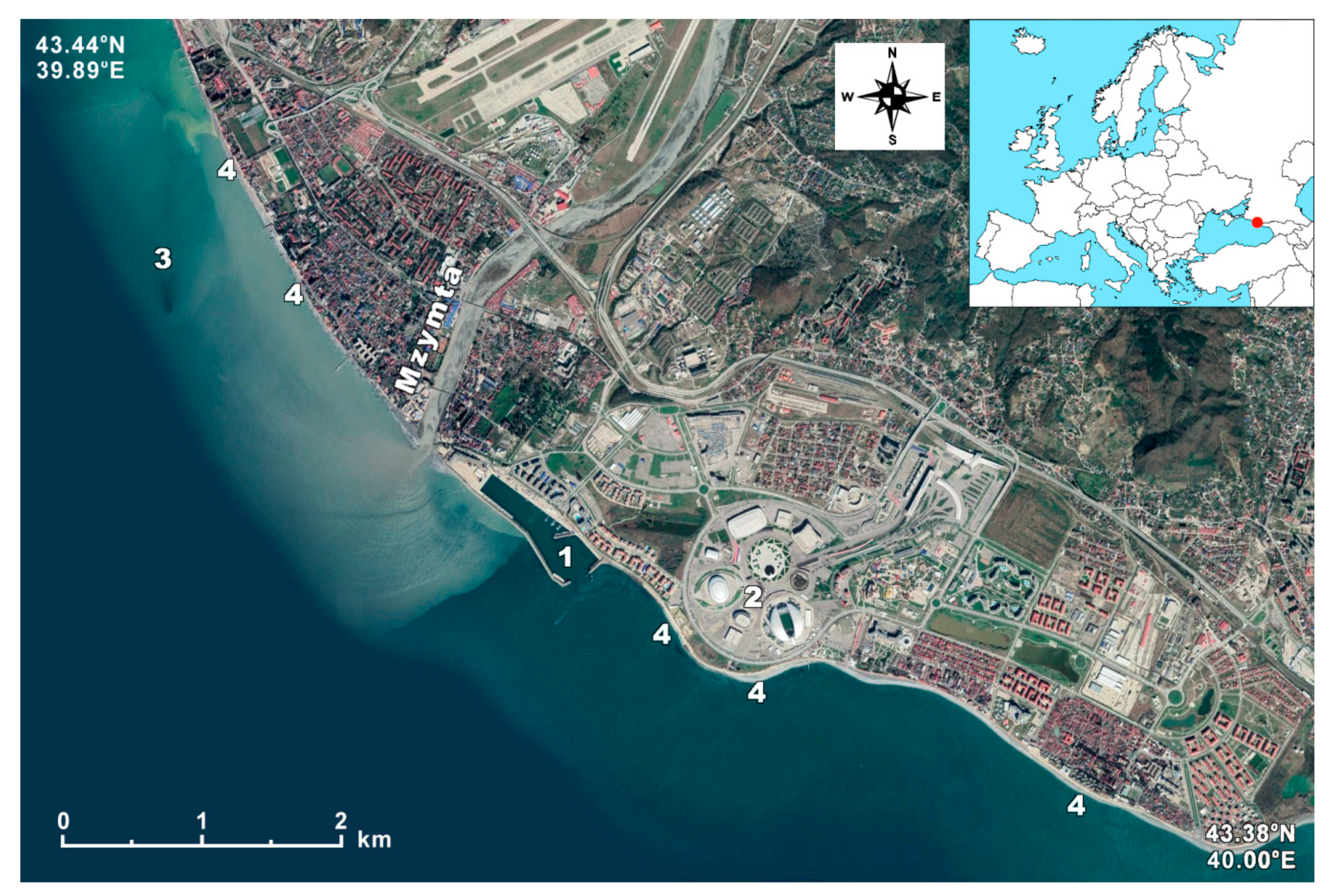



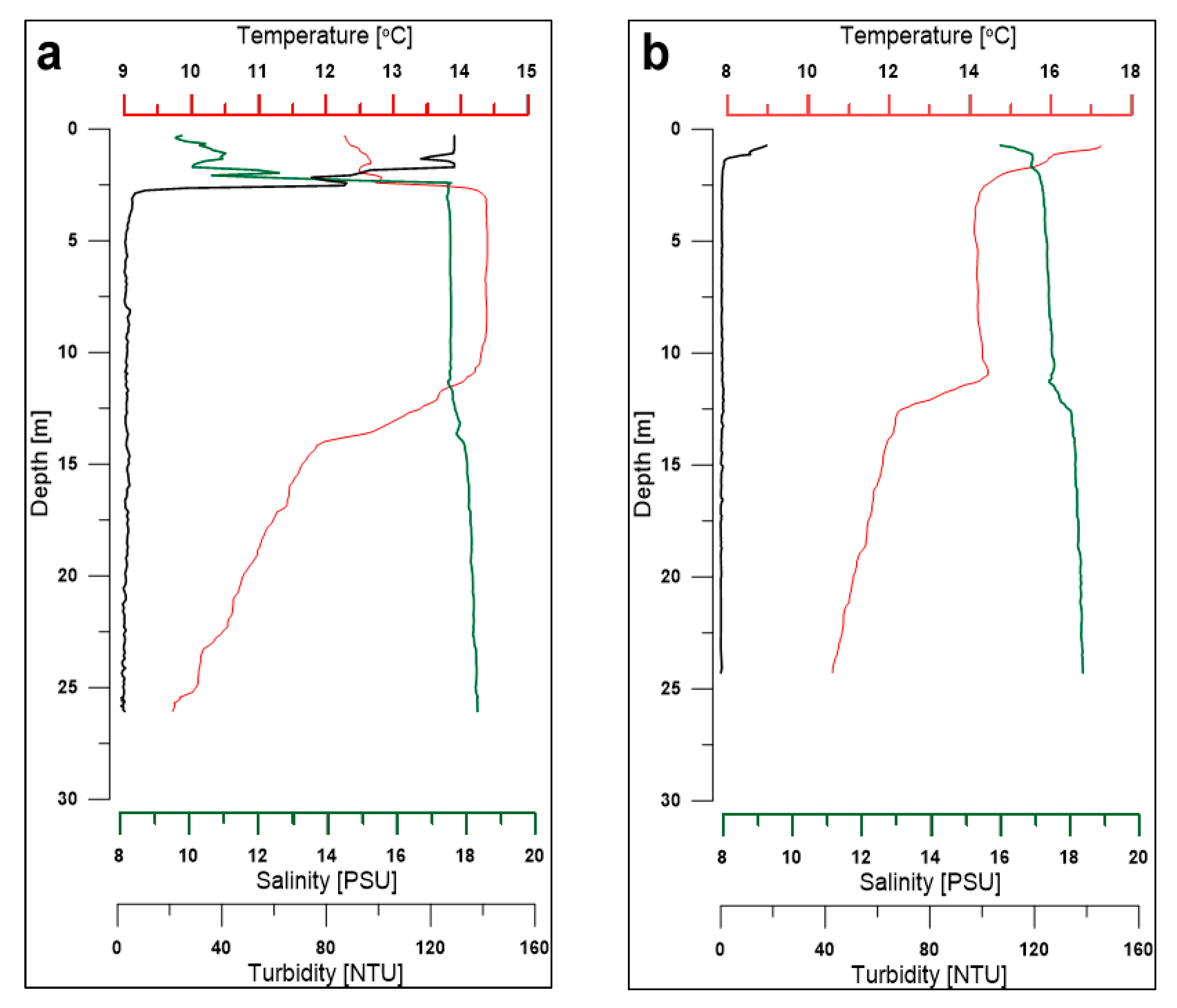
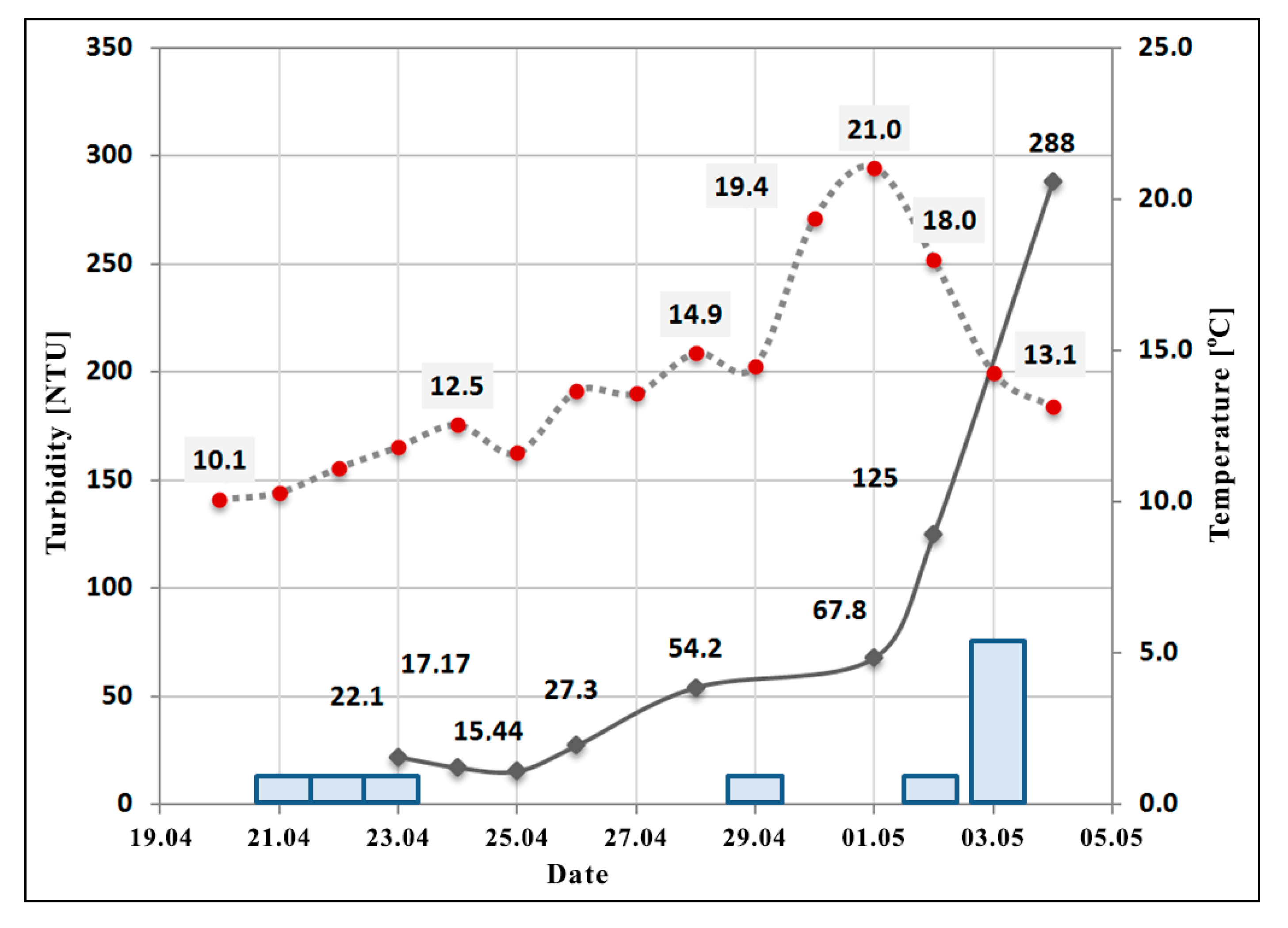
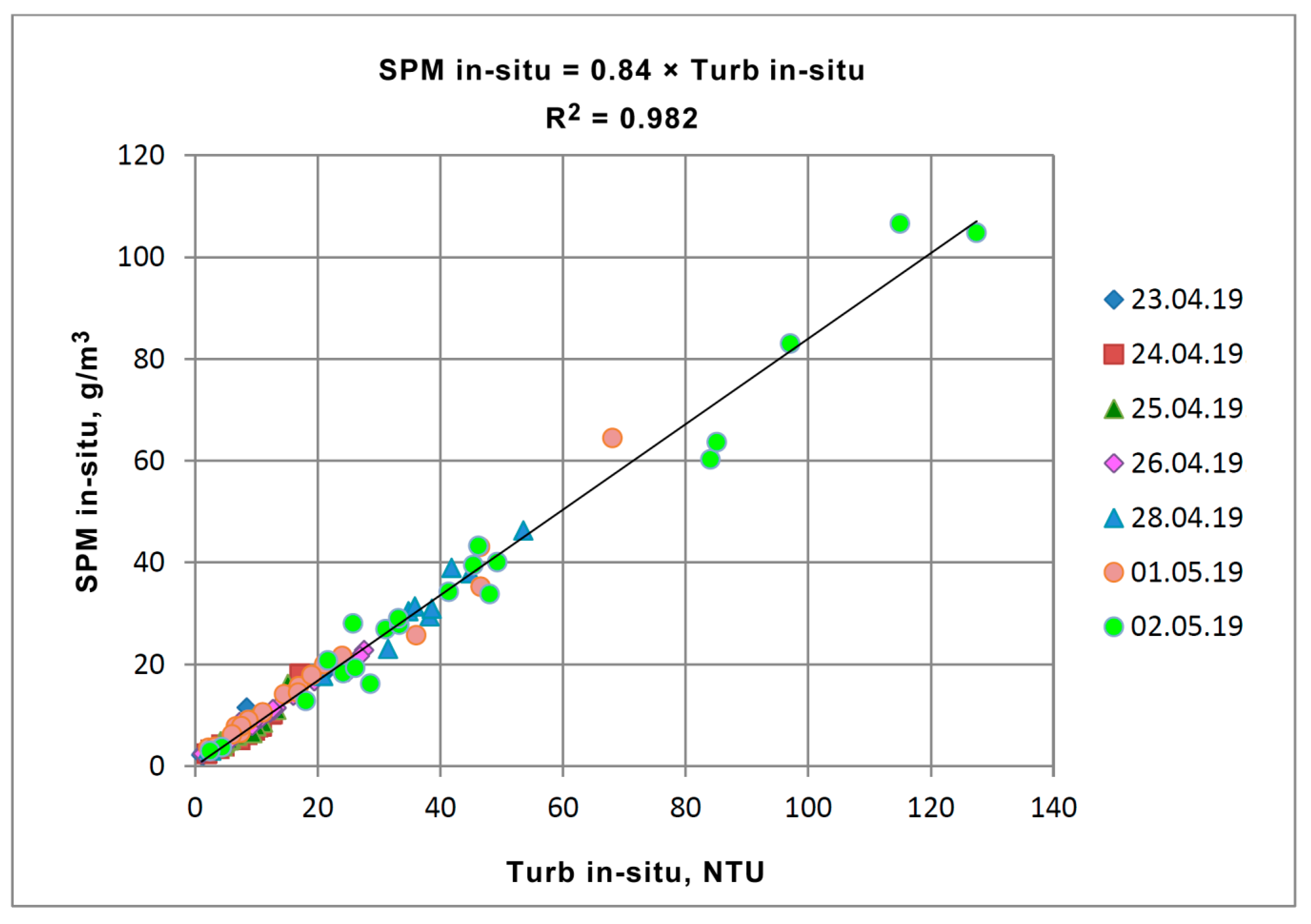

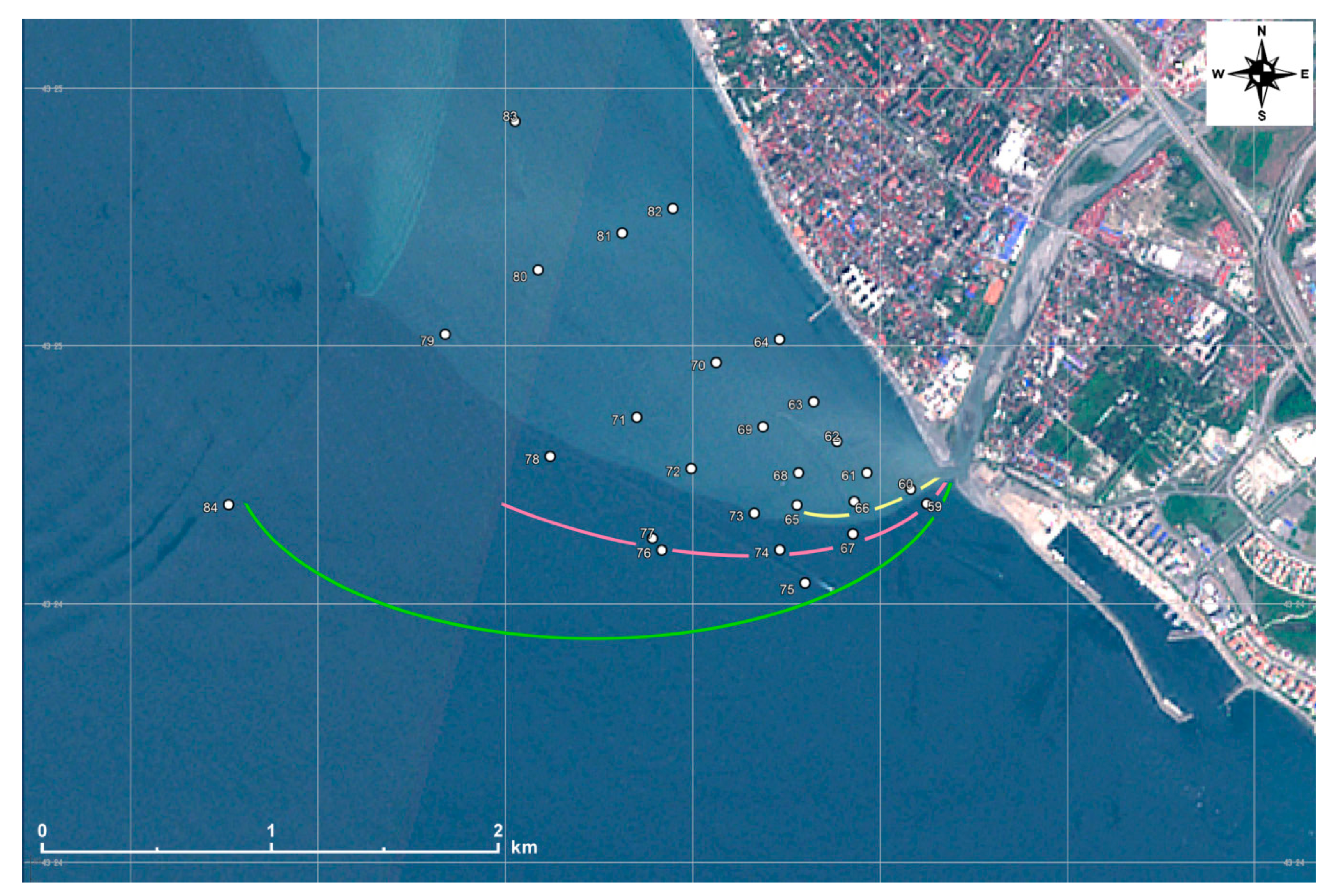

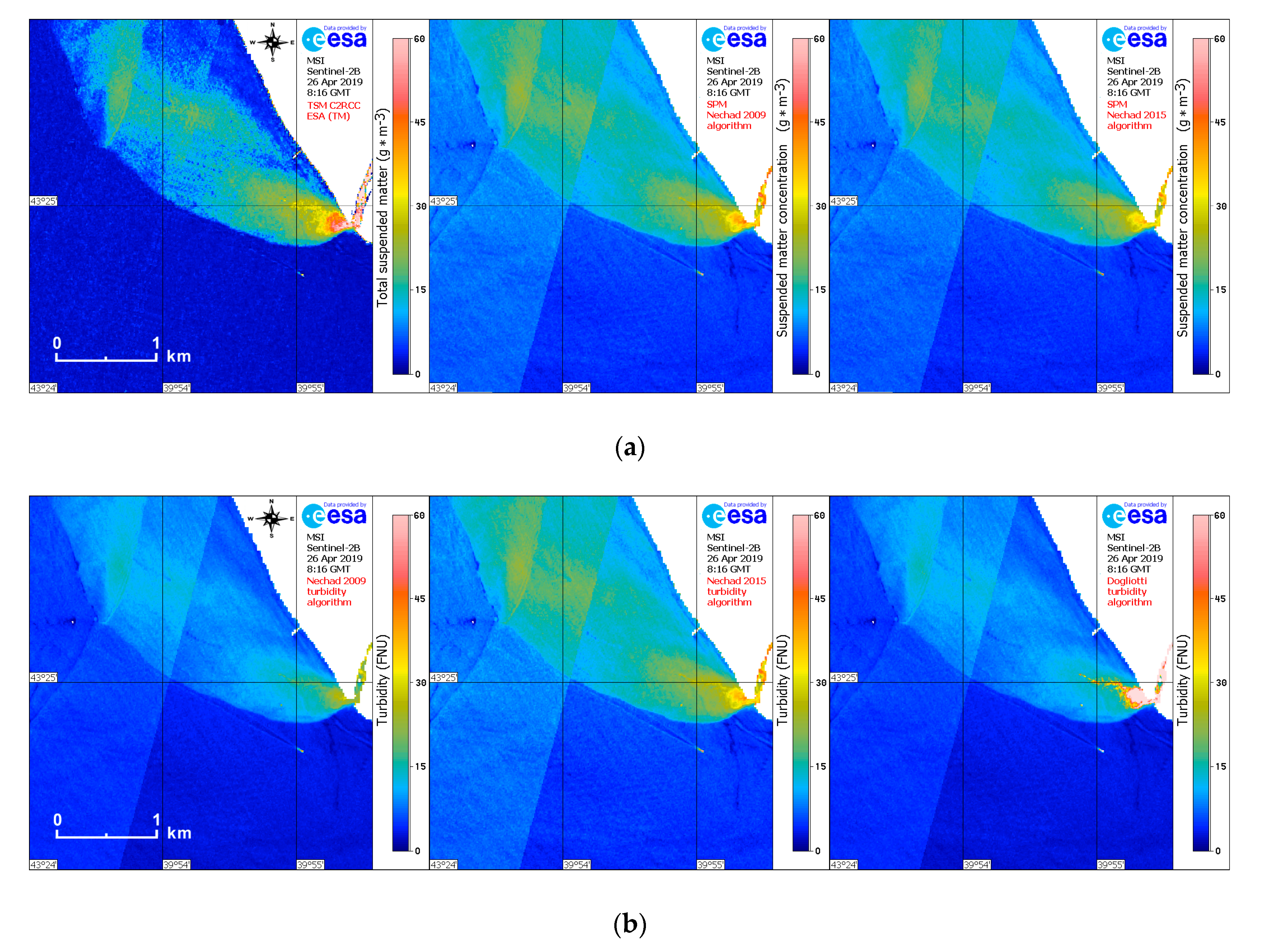


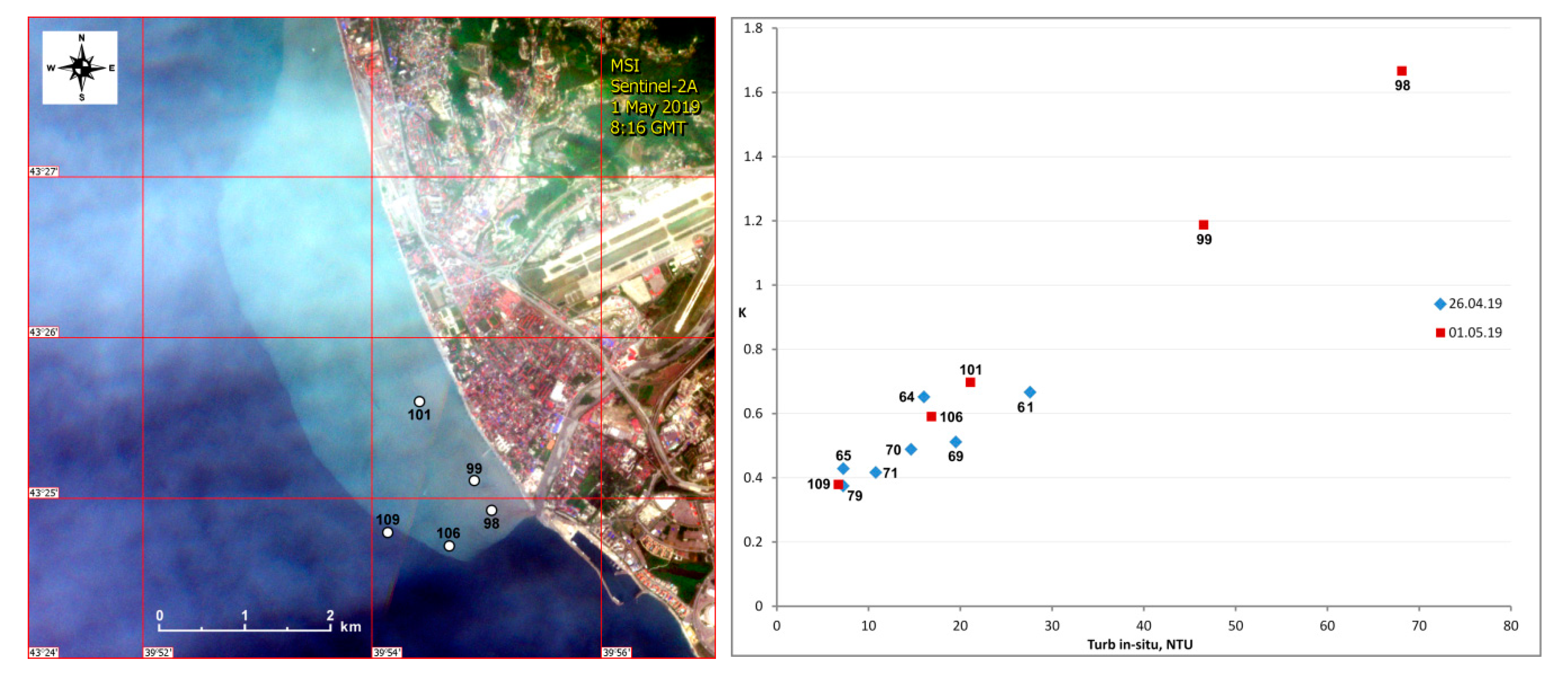
| Parameter | Range | Initial Accuracy | Resolution | Time Constant | Typical Stability/ Per Year | Max. Depth (m) | Sampling Speed (Hz) |
|---|---|---|---|---|---|---|---|
| Conductivity | 0–85 mS */cm | ±0.003 mS/cm | 0.001 mS/cm | ~1 s | 0.010 mS/cm | 200 | 2–6 |
| Temperature | −5 °C to 35 °C | ±0.002° | 0.00005 °C | ~1 s | 0.002 °C | 200 | 2–6 |
| Depth | 0–200 m | ±0.05% FS ** | 0.001% FS | <0.01 s | 0.1% FS | 200 | 2–6 |
| Parameter | Range | Accuracy | Resolution |
|---|---|---|---|
| wind speed | 0–40 m/s | 5%/10 m/s | 0.1 m/s |
| wind direction | 0° to 359.9° | ±3°/10 m/s | 0.1° |
| air temperature | −40 °C to 80 °C | ±1.1 °C/20 °C | 0.1 °C |
| barometric pressure | 300 to 1100 hPa | ±0.5 hPa | 0.1 hPa |
| pinch and roll | 50° | ±1° in range of ±30° | 0.1° |
| Date | Min Temperature, °C | Max Temperature, °C | Min Salinity, PSU | Max Turbidity, NTU | Max SPM, g/m3 | |
|---|---|---|---|---|---|---|
| PT * | TM ** | Water Sample | ||||
| 23 April 2019 | 11.04 | 12.37 | 11.36 | 22 | 31 | 18.7 |
| 24 April 2019 | 11.61 | 13.65 | 10.95 | 13 | 16 | 18.1 |
| 25 April 2019 | 11.17 | 13.24 | 10.38 | 15 | 20 | 16.1 |
| 26 April 2019 | 10.77 | 13.53 | 6.23 | 28 | 31 | 22.8 |
| 28 April 2019 | 11.09 | 14.46 | 6.55 | 54 | 78 | 46.3 |
| 1 May 2019 | 12.69 | 15.50 | 9.24 | 68 | 75 | 64.5 |
| 2 May 2019 | 12.28 | 17.25 | 9.80 | 125 | 129 | 106.6 |
| Date | Station | PT Water Turbidity, NTU | Sampled SPM, g/m3 | Quartz, mas.% * | Feldspars mas.% * | Clay Minerals, mas.% * | Carbonate Minerals, mas.% * | K ** |
|---|---|---|---|---|---|---|---|---|
| 26 April | 60_1 | 28 | 22.8 | 28 | 21 | 42 | 9 | 0.67 |
| 26 April | 64 | 16 | 13.8 | 30 | 24 | 46 | 0 | 0.65 |
| 26 April | 65 | 7 | 7.3 | 19 | 23 | 45 | 10 | 0.43 |
| 26 April | 69 | 20 | 16.6 | 23 | 21 | 45 | 10 | 0.51 |
| 26 April | 70 | 15 | 14.0 | 22 | 24 | 45 | 9 | 0.49 |
| 26 April | 71 | 11 | 9.3 | 16 | 23 | 38 | 22 | 0.42 |
| 26 April | 79 | 7 | 8.6 | 17 | 24 | 45 | 9 | 0.38 |
| 01 May | 98 | 68 | 64.5 | 45 | 20 | 27 | 8 | 1.67 |
| 01 May | 99 | 47 | 43.1 | 38 | 24 | 32 | 6 | 1.19 |
| 01 May | 101 | 21 | 20.0 | 31 | 19 | 44 | 6 | 0.70 |
| 01 May | 106 | 17 | 14.4 | 27 | 19 | 46 | 6 | 0.59 |
| 01 May | 109 | 7 | 7.8 | 22 | 12 | 58 | 8 | 0.38 |
| 02 May | 120 | 97 | 83.0 | 35 | 16 | 45 | 4 | 0.78 |
| 02 May | 125 | 48 | 33.8 | 30 | 15 | 51 | 4 | 0.60 |
| 02 May | 128 | 26 | 19.4 | 24 | 27 | 42 | 6 | 0.58 |
| 02 May | 133 | 41 | 34.3 | 30 | 14 | 51 | 4 | 0.58 |
| 02 May | 137 | 33 | 27.8 | 28 | 19 | 47 | 6 | 0.60 |
| Date | Time UTC | Sensor | Satellite | Pixel Resolution, m | Product | Boat Measurements, Time UTC |
|---|---|---|---|---|---|---|
| 23 April | 08:17 | MSI | Sentinel-2B | 10 | TCI, SPM | 7:42–10:38 |
| 24 April | 07:59 | ETM+ | Landsat-7 | 30 | TCI | 7:33–11:41 |
| 25 April | 08:01 | OLI/TIRS | Landsat-8 | 30/60 | TCI, SST, SPM, CHL | 7:37–11:08 |
| 07:56 | OLCI | Sentinel-3B | 300 | SPM | ||
| 26 April | 07:30 | OLCI | Sentinel-3B | 300 | SPM | 7:27–10:32 |
| 08:27 | MSI | Sentinel-2B | 10 | TCI, SPM | ||
| 10:12 | VIIRS | NPP | 1000 | SST, WLR, CHL | ||
| 28 April | 08:17 | MSI | Sentinel-2A | 10 | TCI (cloud) | 7:37–9:17 |
| 30 April | 07:26 | OLCI | Sentinel-3B | 300 | SPM | No measurements at stations |
| 01 May | 08:27 | MSI | Sentinel-2A | 10 | TCI (cloud) | 7:35–10:56 |
| 02 May | 08:07 | OLI/TIRS | Landsat-8 | 30 | TCI (cloud) | 7:30–11:07 |
| 04 May | 08:02 | OLCI | Sentinel-3A | 300 | SPM | No measurements at stations |
Publisher’s Note: MDPI stays neutral with regard to jurisdictional claims in published maps and institutional affiliations. |
© 2021 by the authors. Licensee MDPI, Basel, Switzerland. This article is an open access article distributed under the terms and conditions of the Creative Commons Attribution (CC BY) license (http://creativecommons.org/licenses/by/4.0/).
Share and Cite
Nazirova, K.; Alferyeva, Y.; Lavrova, O.; Shur, Y.; Soloviev, D.; Bocharova, T.; Strochkov, A. Comparison of In Situ and Remote-Sensing Methods to Determine Turbidity and Concentration of Suspended Matter in the Estuary Zone of the Mzymta River, Black Sea. Remote Sens. 2021, 13, 143. https://doi.org/10.3390/rs13010143
Nazirova K, Alferyeva Y, Lavrova O, Shur Y, Soloviev D, Bocharova T, Strochkov A. Comparison of In Situ and Remote-Sensing Methods to Determine Turbidity and Concentration of Suspended Matter in the Estuary Zone of the Mzymta River, Black Sea. Remote Sensing. 2021; 13(1):143. https://doi.org/10.3390/rs13010143
Chicago/Turabian StyleNazirova, Ksenia, Yana Alferyeva, Olga Lavrova, Yuri Shur, Dmitry Soloviev, Tatiana Bocharova, and Alexey Strochkov. 2021. "Comparison of In Situ and Remote-Sensing Methods to Determine Turbidity and Concentration of Suspended Matter in the Estuary Zone of the Mzymta River, Black Sea" Remote Sensing 13, no. 1: 143. https://doi.org/10.3390/rs13010143
APA StyleNazirova, K., Alferyeva, Y., Lavrova, O., Shur, Y., Soloviev, D., Bocharova, T., & Strochkov, A. (2021). Comparison of In Situ and Remote-Sensing Methods to Determine Turbidity and Concentration of Suspended Matter in the Estuary Zone of the Mzymta River, Black Sea. Remote Sensing, 13(1), 143. https://doi.org/10.3390/rs13010143





